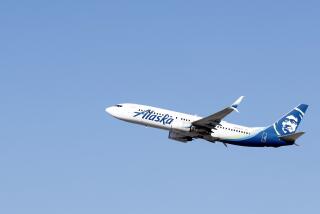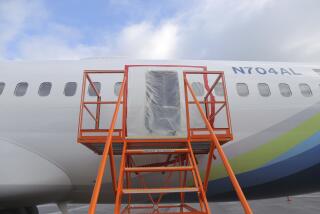A Dangerous Test at McDonnell : Airlines: The aerospace giant is balking at further plane evacuation tests after 49 people were injured recently in Long Beach.
- Share via
The troubling questions remain--even after 49 people were injured and an elderly woman paralyzed, perhaps in vain.
The hurt and disabled were almost predictable victims of an evacuation test that McDonnell Douglas conducted inside a pitch-black hangar last month to satisfy a government safety requirement for its MD-11 jetliner.
The risky drill was a failure in more ways than one. Douglas Aircraft failed to get its mock passengers off the plane fast enough to meet Federal Aviation Administration standards and win certification to fly more passengers aboard the jumbo jet.
But now the aircraft manufacturer is asserting that it has had enough. Douglas, questioning whether the knowledge gleaned from the tests justifies the risks, says it has no plans to conduct further evacuation drills using humans as guinea pigs. The company, like other aircraft manufacturers, says it prefers alternative, less risky methods.
Douglas’ stand puts it at loggerheads with FAA officials, who say they are not about to relax their safety standards after responding to criticism by tightening them in the 1980s. The FAA says the evacuation exercises are necessary, even though about 5% to 10% of test participants invariably end up with broken bones and bruises.
C. O. Miller, the government’s former chief accident investigator and a longtime critic of the evacuation drills, said manufacturers are often more focused on passing the tests than learning anything from them.
“The question is ‘How can I got these people out in 90 seconds?’ and not ‘What kind of hazards will people get into and what can I do to minimize them?’ ” he said.
The test last month resulted in the worst injury in anybody’s recollection. Dorothy Myles, a 60-year-old Long Beach woman, suffered a broken neck in the hysterical moments as she went down the evacuation slide. The accident has left her paralyzed from the neck down and unable to speak.
Douglas spokeswoman Renee Handler said Tuesday that some passengers in the drill may not have been able to see the slide, which was changed from the traditional yellow to silver-blue in an effort to meet higher temperature requirements mandated by the FAA.
“We are presuming that the color of the slide may have been a serious contributing factor in people not getting out of the aircraft,” Handler said.
In an interview, Handler noted that if 20 or 30 passengers spent one additional second to sit down on the slide before jumping out of the aircraft, that could have accounted for the failure of McDonnell to evacuate the aircraft within 90 seconds.
On Oct. 26, Douglas parked the MD-11 inside a hangar and loaded it with 421 people. It took 132 seconds to empty the plane during a first test, in which 28 injuries occurred. The company tried again later in the day, improving its time to 112 seconds, but leaving Myles and 21 other volunteers hurt.
Under FAA rules, McDonnell cannot sell a new configuration of the MD-11--one designed to carry 421 passengers and crew--until the plane passes further evacuation tests.
The original DC-10 jetliner was certified to carry 381 passengers in 1972, when McDonnell was able to evacuate the aircraft in just 75 seconds. And the company believed that an additional 40 passengers could be evacuated in just 15 seconds more.
But since the earlier drills, the FAA has implemented a number of changes to its test standards that made the task more difficult, Douglas officials said.
Handler noted that the FAA required a darkened cabin, a large number of elderly participants and aisles clogged with such obstacles as pillows and briefcases.
“We are not sure to what extent these changes impacted the tests, but that is what we are looking at, and what the FAA is looking at,” Handler said.
McDonnell and the FAA are examining films taken with night-vision cameras to determine why the tests were a failure and what accounted for the serious injuries.
McDonnell’s complaints about the FAA standards could be the groundwork for an eventual demand for certification to fly the reconfigured jet without any further drills. Indeed, Handler said the firm will “review all of our alternatives,” including seeking certification through such alternatives as using computer modeling.
But Anthony Broderick, FAA associate administrator, said evacuation tests cannot be dismissed, citing the hundreds of millions of passengers who fly each year and the critical importance the tests have in certifying aircraft safety.
Broderick said he has seen no evidence that any changes in government requirements accounted for McDonnell’s failure to demonstrate that it could evacuate the aircraft within the required 90 seconds.
“We don’t specify the color of the slide,” Broderick said. “Nobody has ever mentioned that this was a problem before this incident.”
Moreover, Broderick said, the FAA will not accept the failed test in any case, and he suggested that the agency is unlikely to permit McDonnell to conduct the test again without modifications to its procedures or equipment.
“We would not accept this test,” Broderick said. “Where it leaves us inescapably is that it will not allow us to approve the plane for 400 passengers.”
The MD-11 test has renewed a wide range of demands for changes in the evacuation tests themselves.
The Assn. of Flight Attendants is pressing the FAA to reduce the maximum time for evacuating all jets to 60 seconds from 90 seconds. “Ninety seconds simply isn’t realistic,” said Matthew Finucane, safety and health director for the flight attendants union.
Broderick said the agency would consider a recommendation from the union that participants be evacuated onto raised platforms rather than down the inflatable slides. Many of the injuries in evacuation drills, including Myles’ paralyzing neck injury, occur when test participants bolt from planes down the slides.
The high accident rate associated with the tests has prompted some in the industry to push for replacing the tests with computer simulation. “We think we can achieve the same results without putting people at risk,” said Boeing spokesman Tom Cole.
However, Miller, the safety expert, said he doubts that any computer program could show effectively how people respond in an emergency.
Myles, who earned $49 for participating in the Long Beach test, was in the evacuation drill because Douglas did not have enough employee volunteers to meet an FAA requirement that 25% of the participants be over age 50. When the DC-10 was tested in 1972, the agency required that only 5% of participants be that old.
Meanwhile, Broderick said the FAA will examine all of the issues involved in the evacuation tests. “Obviously, this tragedy (at McDonnell) is going to force us to focus more closely on the drills,” he said.
Evacuation Safety The Federal Aviation Administration requires aircraft manufacturers to demonstrate that all the passengers and crew aboard a jet can be evacuated within 90 seconds. The evacuation tests are conducted by having volunteers jump out the aircraft and down a rubber slide, a drill that invariably injuries 5% to 10% of the test subjects.
Test Subjects A quarter of test subjects must be more than 50 years old. Another rule that up to 5% of test subjects be children is being dropped because California dos not permit children to participate. In the Dark Under FAA guidelines, the evacuation tests are conducted inside a pitch black hangar with debris in aircraft aisles. Slide Design The FAA does not regulate the length or the angle of emergency slides. Under industry practice, slides are 30 degrees to 35 degrees when the landing gear is erect or up to 48 degrees if one set of wheel collapses. Silver or Yellow? The MD-11 slide is silver-blue in color. Traditionally, slides were yellow but silver reflects heat better and helps meet FAA regulations requiring slides withstand higher temperatures. McDonnell has argued that the silver slides were less visible to test volunteers.
More to Read
Inside the business of entertainment
The Wide Shot brings you news, analysis and insights on everything from streaming wars to production — and what it all means for the future.
You may occasionally receive promotional content from the Los Angeles Times.











